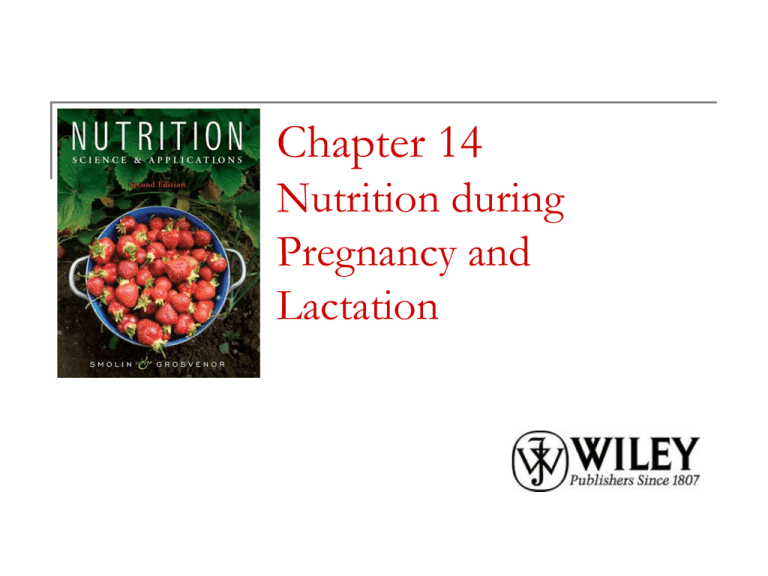
Chapter 14
Nutrition during
Pregnancy and
Lactation
Amniotic sac: a membrane that surrounds
the fetus containing the amniotic fluid
Placenta: an organ produced during
pregnancy from maternal and embryonic
tissues. The placenta secretes hormones,
transfers oxygen and nutrients from
maternal to fetal blood and removes
wastes.
Gestation: the time between conception
and birth, approximately 40 weeks in
humans
Preterm or premature: an infant born
before 37 weeks of gestation
Very low birth weight: a birth weight of
less than 3.3 lbs (1.5 kg)
Small-for-gestational-age: a birth weight
of less than 5.5 lbs
(2.5Inc.
kg)
Copyright 2010, John Wiley & Sons,
One function of the ________ is to
transfer nutrients and oxygen from the
maternal blood to the baby through a
network of blood vessels.
placenta.
amniotic sac.
zygote.
chorion membrane.
Copyright 2010, John Wiley & Sons, Inc.
Infants born at 35 weeks of gestation are
classified as
a)
small-for-gestational-age.
b)
large-for-gestational-age.
c)
premature.
d)
postterm.
Copyright 2010, John Wiley & Sons, Inc.
The recommended weight gain during
pregnancy for a healthy, normal weight
women is approximately ___________
pounds.
5 - 10
15 - 20
25 - 30
40 - 50
Copyright 2010, John Wiley & Sons, Inc.
Distribution of
Weight during
Pregnancy
Copyright 2010, John Wiley & Sons, Inc.
Recommendations for Weight Gain
during Pregnancy
Copyright 2010, John Wiley & Sons, Inc.
Pattern of Weight Gain during Pregnancy
Copyright 2010, John Wiley & Sons, Inc.
Weight gain recommendations during
pregnancy are based on
a)
weight at the time of
conception.
b)
c)
ethnicity.
waist-to-hip circumference
ratio at the time of
conception.
d)
ultrasound results (used to
size the infant) taken during
the first trimester of
pregnancy.
Copyright 2010, John Wiley & Sons, Inc.
Physical activity during pregnancy
Copyright 2010, John Wiley & Sons, Inc.
Physical Activity during Pregnancy
Copyright 2010, John Wiley & Sons, Inc.
Discomforts of Pregnancy
Physiological changes during pregnancy can
cause uncomfortable side effects for the
mother. These can include:
Edema
Morning sickness
Heartburn
Constipation and hemorrhoids
Copyright 2010, John Wiley & Sons, Inc.
Complications of Pregnancy
Pregnancy can cause complications for the
mother and the child. These can include:
Pregnancy-induced hypertension, which includes
gestational hypertension, preeclampsia and
eclampsia
Gestational diabetes mellitus
Copyright 2010, John Wiley & Sons, Inc.
Gestational Diabetes:
Pregnant women who have never had diabetes before but who have high
blood sugar (glucose) levels during pregnancy are said to have
gestational diabetes. Gestational diabetes affects about 4% of all
pregnant women - about 135,000 cases of gestational diabetes in the
United States each year.
We don't know what causes gestational diabetes, but we have some
clues. The placenta supports the baby as it grows. Hormones from the
placenta help the baby develop. But these hormones also block the
action of the mother's insulin in her body. This problem is called insulin
resistance. Insulin resistance makes it hard for the mother's body to use
insulin. She may need up to three times as much insulin.
Gestational diabetes starts when your body is not able to make and use
all the insulin it needs for pregnancy. Without enough insulin, glucose
cannot leave the blood and be changed to energy. Glucose builds up in
the blood to high levels. This is called hyperglycemia.
http://www.diabetes.org/diabetes-basics/gestational/what-is-gestationaldiabetes.html
Copyright 2010, John Wiley & Sons, Inc.
Nutritional Needs
of Pregnancy
Energy Needs
1st trimester- same needs
2nd trimester- extra 340 calories/day
3rd trimester- extra 452 calories/day
Copyright 2010, John Wiley & Sons, Inc.
What is in a Prenatal Supplement?
Copyright 2010, John Wiley & Sons, Inc.
Factors that Increase Pregnancy Risk
Copyright 2010, John Wiley & Sons, Inc.
Factors that Increase Pregnancy Risk
Copyright 2010, John Wiley & Sons, Inc.
Micronutrient
Needs of
Pregnant Teens
Copyright 2010, John Wiley & Sons, Inc.
Which of the following is the correct sequence of
gestational events:
embryo; fetus; zygote
zygote; embryo; fetus
fetus; embryo; zygote
zygote; fetus; embryo
What’s the most common birth defect?
Copyright 2010, John Wiley & Sons, Inc.
Fetal Development
Copyright 2010, John Wiley & Sons, Inc.
Physiology of Lactation
Lactation involves the synthesis of milk components,
including protein, lactose and lipids, and the movement
of the milk through the milk ducts to the nipple.
Colostrum is immature milk, secreted during the first
days after delivery. Colostrum is rich in protein and
immune factors.
The release of milk from the glands through the ducts is
referred to as let-down.
The let-down of milk is triggered by the hormone
oxytocin.
Copyright 2010, John Wiley & Sons, Inc.
Physiology of Lactation
Copyright 2010, John Wiley & Sons, Inc.
Maternal Nutrient Needs during
Lactation
The need for nutrients is even greater during lactation
than during pregnancy.
Human milk contains about 160 kcalories per cup (240
ml).
The EER for lactation is estimated by adding the TEE
of nonlactating women and the energy in the milk and
then subtracting the energy supplied by maternal fat
sources.
Lactating women require approximately an additional
liter of fluid a day.
Copyright 2010, John Wiley & Sons, Inc.
Nutritional Needs of Infants
Copyright 2010, John Wiley & Sons, Inc.
Nutritional Needs of Infants
Copyright 2010, John Wiley & Sons, Inc.
Assessing
Infant Growth
failure to thrive: inability of a
child’s growth to keep up with
normal growth curves
Copyright 2010, John Wiley & Sons, Inc.
Comparing Breast Milk and Formula
Copyright 2010, John Wiley & Sons, Inc.
How long should breast feeding
continue?
Physiologicaly, lactation can continue as long
as suckling is maintained
Breast feeding alone is sufficient to support
optimal growth for ~ 6 months
Currently, only 17% of infants are exclusively
breast fed for 6 months
After 12 months, the baby no longer needs
breast milk for nutritional needs
However, breast feeding can provude
nutrition, comfort, bonding.
Copyright 2010, John Wiley & Sons, Inc.
Breast Pumps Can Be Used for Bottle
Feedings
Copyright 2010, John Wiley & Sons, Inc.
Position of Bottle is Important
Copyright 2010, John Wiley & Sons, Inc.
Chapter 14
Copyright 2010 John Wiley & Sons, Inc.
All rights reserved. Reproduction or translation of this work beyond
that permitted in section 117 of the 1976 United States Copyright Act
without express permission of the copyright owner is unlawful.
Request for further information should
be addressed to the
.
Permissions Department, John Wiley & Sons, Inc. The purchaser may
make back-up copies for his/her own use only and not for distribution
or resale. The Publisher assumes no responsibility for errors,
omissions, or damages caused by the use of these programs or from
the use of the information herein.
Copyright 2010, John Wiley & Sons, Inc.









